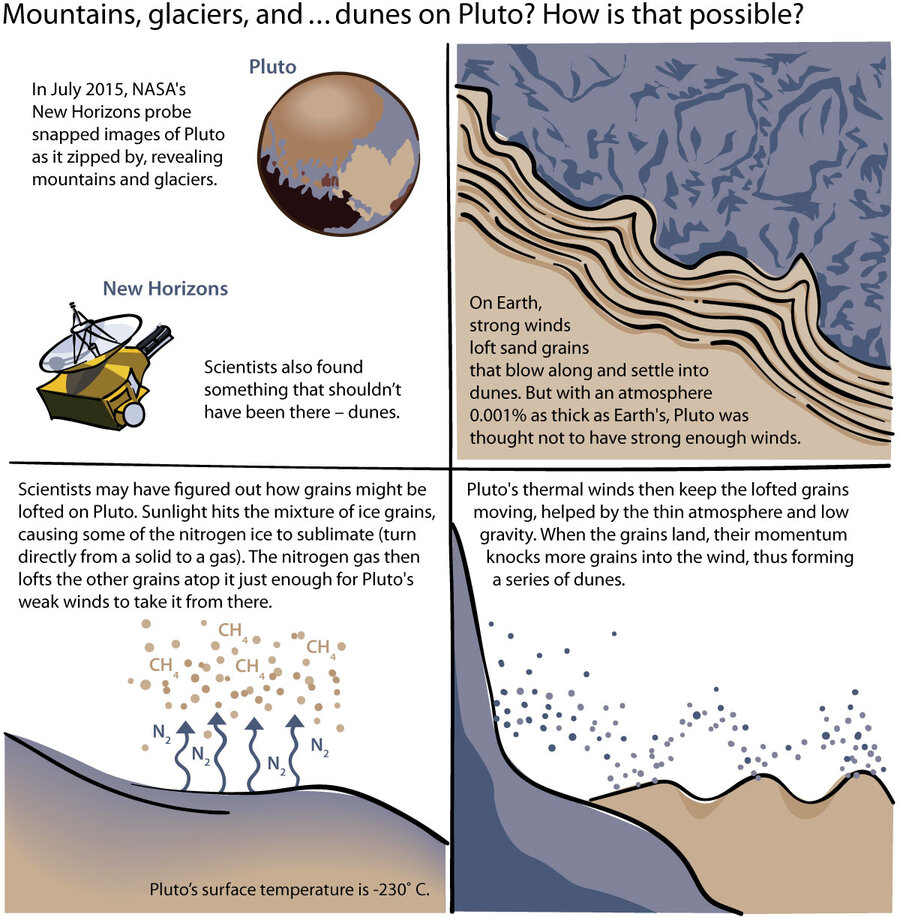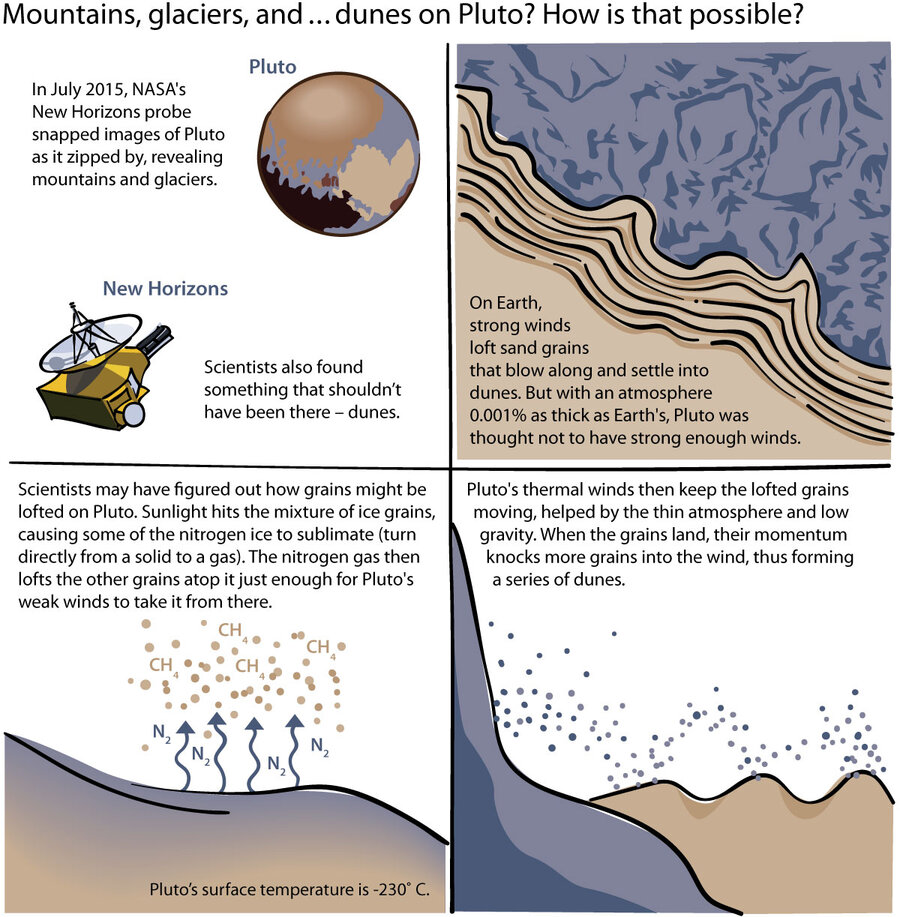Pluto was shrouded in mystery until NASA’s New Horizons probe zipped by the dwarf planet almost three years ago. As images transmitted back to Earth, Pluto went from a fuzzy dot to a complex world. Between towering mountains, flowing nitrogen ice glaciers, and blue skies, surprises abounded.
But after spotting a striped pattern on the edge of the Sputnik Planitia ice plain that looked remarkably like sand dunes found on Earth, scientists were left scratching their heads. Dunes on Earth require strong winds to form, and Pluto’s atmosphere was thought to be far too thin for such winds to exist on the dwarf planet. And yet there the stripes were.
Since the dune-like features were first revealed in New Horizons images, scientists have debated whether or not they are indeed dunes, and how they may have formed. How could something that seems impossible be right there before their eyes?
For planetary scientists, encountering impossibilities is just part of the job. These scientists have to think beyond what they know, keeping an open mind and collaborating with others to put as many possibilities on the table.
That’s just what happened with the Plutonian dune mystery. An interdisciplinary, international team came together to propose a mechanism that might explain the presence of dunes on Pluto in a paper published Thursday in the journal Science.
When the images started to come back from New Horizons, “we looked at these things and said, ‘My goodness, they look like dunes’,” says Matt Telfer, lead author of the paper and a lecturer in physical geography at Britain’s University of Plymouth. But “how is this possible given the low atmosphere that we’ve got here?”
Pluto’s atmosphere is 0.001 percent as thick as Earth’s. On Earth, the thicker atmosphere means that winds can be strong enough to lift sand grains into the air, and then carry them along the surface of the planet.
At first, Dr. Telfer and his colleagues struggled to come up with a scientific basis for the existence of such windblown formations.
Then, in what Telfer calls a “serendipitous moment,” Eric Parteli, a computational geoscientist at the University of Cologne in Germany, approached the team. According to Dr. Parteli’s calculations, just enough of a wind could blow on Pluto to carry grains of ice along the surface to form dunes. The problem was that it wasn’t strong enough to loft those ice grains in the air in the first place.
Rather than seeking an explanation based on processes found on Earth, the now-interdisciplinary team began thinking about other active processes on Pluto that might provide that initial lift. To shift their frame of reference, they turned to the make up of the region where the dunes appeared: a mixture of nitrogen and methane ice.
Given those ingredients, the team identified a possible mechanism to loft grains. Although Pluto is far from the sun, some sunlight does reach the surface and can heat it up enough to cause nitrogen to sublimate (turn directly from a solid to a gas). Because nitrogen sublimates at a lower temperature than methane, the team surmised that the rising gas might create enough upward pressure to loft the still-solid methane grains just enough for a thermal wind to take it from there.
Not everyone thinks that this mechanism is a slam dunk explanation, or even that there are certainly dunes on Pluto.
“That’s the funny thing about images of other worlds’ surfaces,” says Lori Fenton, a planetary scientist at the SETI Institute in Mountain View, Calif. “We take these images and it’s really hard to interpret what we see, so we try to apply what we know from Earth and what we’ve explored and confirmed on other worlds. So they’re sort of testing a hypothesis there, and they’ve got some evidence that supports it. But until we go back to Pluto, we won’t know for sure.”
Getting creative
Dunes have appeared in surprising places before. They show up on Mars, Venus, and Saturn’s moon Titan.
For Ralph Lorenz, a planetary scientist at the Johns Hopkins University Applied Physics Laboratory and a member of the radar team on NASA’s Cassini mission to Saturn, finding dunes on Titan was not anticipated. In 1995, Dr. Lorenz wrote a paper explaining why the Cassini mission would probably not find dunes on Titan, but it turned out that about a fifth of the moon is covered in giant dunes.
“So that prediction was spectacularly wrong,” Lorenz says. “And that was great. That’s why we do science. We get a kick out of having to reevaluate the world.”
Neither Pluto nor Titan are the most surprising places scientists have found a bedform (a windblown feature that could be dunes or ripples). A pattern that looks just like a bedform was spotted by the European Space Association’s Rosetta probe on Comet 67P/Churyumov-Gerasimenko in 2014. It surprised scientists, says Dr. Fenton, but there are already a few different ideas being discussed about how a windblown feature may have formed on an airless body.
“It takes us by surprise, we look at each other, and then we slowly start to throw out ideas and test them,” she says.
Scientists start by making sure that they’re really seeing what they think they’re seeing. Inferring a landscape feature based off patterns seen from orbit can be difficult because many things can form similar basic patterns, says Ryan Ewing, a planetary scientist at Texas A&M University.
At the start, planetary scientists keep an open mind about what planetary processes could possibly be at play.
“[Planetary scientists] read a much broader literature than a lot of scientists do,” Fenton says. “And it’s simply because we need to draw ideas from these disparate fields and see if these ideas might apply to some crazy environment out there in the solar system somewhere.”
For many scientists, that means being social. Some of the most interesting ideas can come out of casual conversations in the hallways at conferences with scientists in other disciplines, or by hearing a scientist in another field’s wild theories that might prompt you to think about your own topic in new ways.
Telfer says the interdisciplinary nature of the team working on the Plutonian dune question was key. “We needed each other,” he says.
This helps scientists stay humble, too. “Everyone wants their hypothesis to be the one that is most consistent. If you’re not careful, people can get entrenched in their thinking and be unwilling to change,” Dr. Ewing says. But a team setting pushes people to defend their hypothesis, a process that improves the science.
Planetary scientists have to be open to any possibility – or even impossibility – just by the nature of their research. “We’re forced to think outside the box when we see these strange worlds,” Fenton says. “It’s the reason I study planetary science, because we’re always seeing new things that are completely out of the range of what we would expect.”








